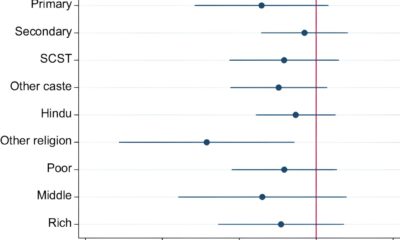Health
Despite the COVID-19 pandemic, health improvements occurred worldwide since 2010, but progress has been uneven: study

Credit: Unsplash/CC0 public domain
The number of premature deaths and ill health due to HIV/AIDS and diarrhea has halved since 2010, and the burden of disease due to injuries has fallen by a quarter over the same period, taking into account differences in age and population size across countries, based on a new study published in The Lancet.
The study measures the burden of disease in years lost due to premature death and poor health. The findings show that the total burden of disease worldwide fell by 14.2% between 2010 and 2019. However, the researchers found that the COVID-19 pandemic has interrupted these downward trends: the burden of disease has increased since 2019 by a total of 4.1% in 2020 and 4.1% in 2020. 7.2% in 2021. This is the first study to measure premature death and disability from the COVID-19 pandemic worldwide and compare it to other diseases and injuries.
The research shows how healthy life expectancy, the number of years a person can expect to live in good health, has increased from 61.3 years in 2010 to 62.2 years in 2021. By pinpointing the factors driving these trends , the researchers point to rapid improvements within healthcare. the three different categories of disease burden: communicable diseases, maternal diseases, neonatal diseases and nutritional diseases; non-communicable diseases; and injuries.
Among communicable diseases, maternal diseases, neonatal diseases and nutritional diseases, the burden of disease decreased between 2010 for neonatal diseases (diseases and injuries that occur uniquely in the first month of life), lower respiratory infections, diarrhea, malaria, tuberculosis and HIV/AIDS. and 2021, ranging from reductions of 17.1% for neonatal conditions to 47.8% for HIV/AIDS. In the non-communicable disease category, the burden of disease due to stroke decreased by 16.9%, while the burden of disease due to ischemic heart disease decreased by 12.0% during this period.
In terms of injuries, the number of healthy years of life lost due to traffic accidents has been reduced by almost a quarter (22.9%), while the burden of disease due to falls has decreased by 6.9%. Progress in reducing the burden of disease varies depending on countries’ socio-demographic index – a measure of income, fertility and education – highlighting inequalities. For example, the burden of disease due to stroke fell by 9.6% between 2010 and 2021 in countries with the lowest socio-demographic index, but fell faster – by 24.9% – in countries with a higher socio-demographic index.
“Our study highlights both the world’s successes and failures,” said Dr. Alize Ferrari, associate professor at the University of Washington’s Institute for Health Metrics and Evaluation (IHME), honorary associate professor at the University of Washington’s School of Public Health the University. from Queensland, and co-first author of the study.
“It shows how the world has made tremendous progress in expanding treatment for HIV/AIDS and combating vaccine-preventable diseases and deaths among children under five. At the same time, it shows how COVID-19 has exacerbated inequalities, creating the greatest burden of disease in countries with the fewest resources, where healthcare systems were strained and vaccines were difficult to obtain. Governments should prioritize equitable pandemic preparedness and work to maintain the momentum we have seen in improving children’s health.
The study presents updated estimates from the Global Burden of Diseases, Injuries, and Risk Factors Study (GBD) 2021. The GBD 2021 study analyzes incidence, prevalence, years lived with a disability (years lived in less than ideal health), and disabilities. -adjusted life years (years of healthy life lost) at global, regional, national and subnational levels. It presents estimates of health and health loss in age-adjusted rates and overall rates per 100,000 people.
The study provides globally comparable measures of healthy life expectancy and is the first to fully evaluate the burden of disease during the first two years of the COVID-19 pandemic. COVID-19 was the leading cause of disease burden worldwide in 2021, accounting for 7.4% of the total disease burden worldwide.
The study also examined how the COVID-19 pandemic affected men and women differently. The researchers found that men were more likely to die from COVID-19 than women; the age-standardized disease burden for COVID-19 among men was almost twice as high as that among women. However, the secondary effects of the COVID-19 pandemic, including long-term COVID-19 and mental health disorders, are hitting women the hardest. For example, women were twice as likely as men to develop long-term COVID.
Depression, which increased sharply during the pandemic, mainly affected women between the ages of 15 and 65. Looking at differences between age groups, COVID-19 caused the most disease burden in older adults. Before COVID-19, adults aged 70 and older had more than double the disease burden compared to adults aged 50 to 69.
The study not only highlights the diseases and injuries that shorten life and cause poor health, and how the burden of disease from different causes has changed over time, but also examines how these patterns vary across countries and regions. “In essence,” the authors write, the study “provides a comprehensive toolkit to inform and improve decision-making processes at various levels of governance and practice.”
GBD 2021 sheds light on the various causes of the disease burden and shows which have improved and which are stagnating or worsening. It also indicates the number of years that people live healthy. Healthy life expectancy increased significantly in 59 countries and territories between 2010 and 2021, with the greatest improvements in the countries lowest on the socio-demographic index: from 52.2 years in 2010 to 54.4 years in 2021.
In contrast, healthy life expectancy showed minimal change across countries in the highest levels of the socio-demographic index, declining slightly from 68.9 years in 2010 to 68.5 years in 2021. The findings on healthy life expectancy show that, Although people are living longer all over the world, they are not spending all those years in good health. The researchers found that the main causes of poor health were low back pain, depressive disorders and headache disorders.
“With low back pain, the leading cause of poor health worldwide, we see that existing treatments are not working well to address it,” said Dr. Damian Santomauro, Assistant Professor of Health Metric Sciences at IHME; Stream Lead at the Queensland Center for Mental Health Research; Adjunct Fellow at the University of Queensland School of Public Health; and co-first author of the study. “We need better tools to manage this major contributor to the global burden of disease.”
“For depressive disorders, on the other hand, we know what can work: therapy, medication or both in combination for an adequate period of time. Unfortunately, however, most people in the world have little or no access to treatment,” he said. “Given how depression has increased dramatically during the COVID-19 pandemic, there is an urgent need to ensure that everyone with this condition can receive treatment.”
Another way to understand what makes people sick is to look at which diseases are growing the fastest. GBD 2021 shows that diabetes had the fastest growth among the various causes of ill health, what the researchers call years spent living with disability. The number of age-adjusted years with disability due to diabetes increased by 25.9% between 2010 and 2021. Poor health due to diabetes increased in every country and area the researchers studied.
“Diabetes is a major contributor to stroke and ischemic heart disease, which are among the three leading causes of disease burden worldwide,” said Dr. Theo Vos, professor emeritus at IHME and one of the senior authors of the study. ‘Without intervention, more than 1.3 billion people by 2050 the entire world will be living with diabetes. To combat the threat of diabetes, we must ensure that people in all countries have access to preventive care and treatment, including anti-obesity medications, which can lower a person’s risk of developing diabetes. “
More information:
The Lancet (2024). www.thelancet.com/journals/lan … (24)00757-8/fulltext
Quote: Health improvements occurred worldwide since 2010 despite the COVID-19 pandemic, but progress has been uneven: Study (2024, April 17) retrieved April 18, 2024 from https://medicalxpress.com/news/2024-04-health- worldwide-covid-pandemic-unequal.html
This document is copyrighted. Except for fair dealing purposes for the purpose of private study or research, no part may be reproduced without written permission. The content is provided for informational purposes only.













